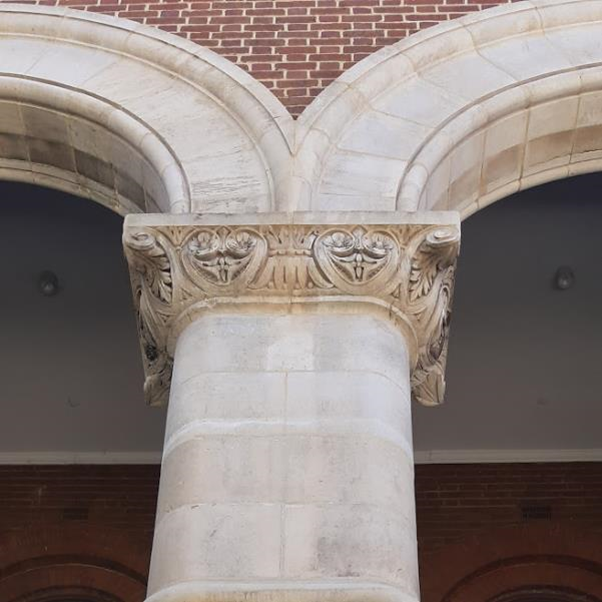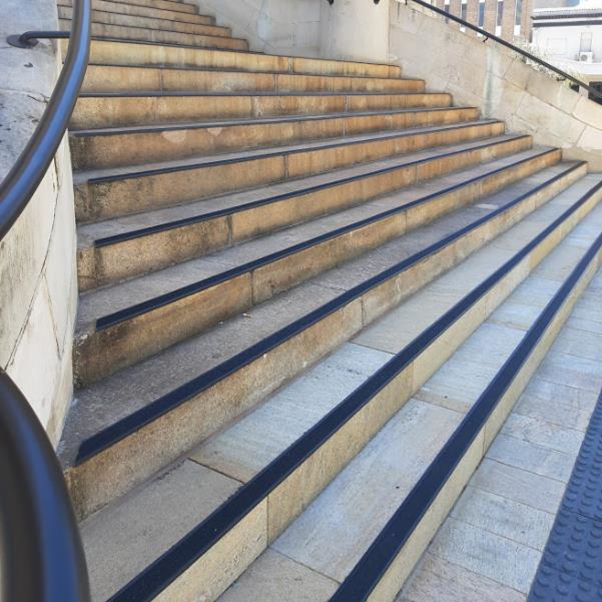
Right now, we need an environment which is good for the human spirit. Spaces which make us connect with each other, not drive us further apart. Great architecture will not vaccinate a nation or cure racism, but it creates places where we can work together to solve our problems. Buildings can unite or divide, and we need more of the former.
With that somewhat purple prose preface, I want to look at a work of genius: George Temple-Poole’s Jubilee Building (1899). This is a personal reflection on what it means to me, although hopefully you’ll agree. A few features I describe have a functional reason for being there, and some are present simply because of tradition. But this is not a story of origins or historical precedent, this is an account of what the building means right now. To me.
Like a movie or novel, buildings have a beginning, a middle and an end. The job of the architect is to provide a narrative structure which unites these three elements and leaves the viewer both satisfied and uplifted. Poole succeeds on every level. With that in mind, let’s start at the very beginning, a very good place to start. How does the Jubilee Building connect itself to the ground?

The lowest level is of stone, rusticated stone to be precises. The rough exterior of the blocks leads to reading them as natural, a product of nature not of pure architecture. In one sense this is a lie, every block has been quarried and shaped for its purpose. But the psychological effect is to see the building as emerging naturally from the ground, not forcibly placed upon it. An essay for grad school architectural history would use words like ‘chthonic’, but I don’t need to be pretentious here. So, I’ll just say the Jubilee Building is rooted like a tree. Trees grow from the soil they do not simply sit on it.

Now Poole has set himself a problem to solve: he has to transition from the natural to the architectural, and do so in a way which makes the jump seamless. Like a movie director, harsh cuts can work but only if you mean to disorientate the viewer. The Jubilee Building’s solution is so perfect and appears so obvious, it’s easy to miss the small details required to make this work. What could be a harsh line between one type of stone and another is mediated by the pediment of each column being rusticated between smooth sheets of stone. Nature is giving way to art but there is an intermediate step when they are in perfect harmony. Like a ruined monastery being reclaimed by ivy, art and nature are both present on this level, not in competition but in symbiosis.

As if this wasn’t enough of a genius move, at the base of each pediment are a matching pair of tiny leaves. This is our first hint of the organic and, like the first leaves of spring, promises further growth as we continue our voyage together towards the climax of the story. If you can’t tell already, it is things like this attention detail which make me fall in love with great buildings.
After the organic detail and the rusticated pediment, the columns themselves are smooth, art not nature, before we reach the capitals. The biggest problem any architect must resolve is how to transition from the vertical to the horizontal. Done abruptly, it can seem harsh and even oppressive. The downwards force of the lintel is always met by the upwards thrust of the post, which if not handled correctly will look like competition not cooperation. And this influences the viewer. Today we need to work together not against each other, so require spaces which reflect this desire.

The Jubilee Building doesn’t use the post and lintel system, but the Romanesque series of springing arches. Even so, there has to be a point of mediation between the arch and the column and here it is, no surprise, achieved in a perfect way. The capitals of the columns, which are roughly of the Corinthian order, are a delight to examine. The solitary leaf at the base has become a riot of intertwining organic forms at the top. Not only is this a moment for the eye to pause and simply admire beauty, and it suggests the arches are resting on a soft bed, not a harsh stone column. More like sleeping on grass than curled up on a concrete floor. This is the architecture of kindness.
I could go on forever about this façade, but hopefully the above has convinced you this is a building made for human beings. Each transition, from ground to base to pediment to capital to arch has been undertaken to engage you, to make them seamless and natural. And the natural is emphasised by the organic forms because nature calms us and makes us feel safe. If you are unpersuaded by all the scientific studies on this, further proof is offered by every culture on Earth using natural forms in their architecture.

Poole makes the place more welcoming to the human being by setting back the next storey well behind the James Street façade. Instead of towering over us like an authoritarian figure, the building is deliberately on a human scale. We feel welcomed because the Jubilee Building was designed for us, with our regular-sized bodies. Not only can our gaze take in the whole frontage, it seems as if once inside it will have spaces which make us feel comfortable.

But grandeur is not absent from the place, since the main entrance projects high above the surrounding wings. I’ll get there, but first a brief diversion about the staircase. The entry is elevated and to get there you have to climb some stairs, suggesting the contents of the museum and art gallery will elevate your soul, just as you are physically ascending to get there. And note how the stairs widen at the base, calling people from all directions to come to the building and, on leaving, offering a choice of directions to go with your new-found enlightenment. Just wow.
Of course, despite the powerful symbolism of the stairs, they also represent an obstacle to people with mobility issues. Hopefully, everyone agrees universal access is a human right, but it is still possible to read these steps as a democratic call to partake in the best of our collective knowledge and culture while recognising other solutions are required today. (As they were then, but that’s a separate issue.) And I know Poole’s solution is attractive because when taking the photos for this post, a number of people climbed these stairs and were disappointed by the sealed doors at the top. This is such a mesmerising entrance, it overrides any signage pointing you to the new one.

Back to the entrance as a whole. It looks like a church, a secular temple to knowledge. And this is hardly unintentional, many places like this did, most famously the Natural History Museum in London. Even so, the imposing scale needs to be humanised and Poole achieves this in spectacular fashion. The original plans for the building show the frieze above the door was to have been decorated with organic forms but it was finally left blank. This is unfortunate, since it would have beautifully tied this façade with the rest of the building. Perhaps someone could organise this and make the entrance even more perfect. Perhaps.
This frieze breaks up the double-storey façade and introduces a visual pause before the ‘church’ windows above. These, while firmly continuing the vertical trajectory of our gaze and mediated by mini towers and a pointed gable. All of this points upwards towards the sky and instead of an abrupt termination, suggests the building meets the air with grace rather than violence. The onion domes on the towers gradually transition from full width to a point. The potential for knowledge and culture is sky high. Literally.
And the move from building to space above is the culmination of our tale. The climax of a story which, like many movies, suggests a sequel to follow, but it’s a sequel to be written from your experience within the building. Imagine what would happen if another building was oppressively built over this space. It would ruin the story. Hopefully, no one will ever contemplate such a thing. The Jubilee Building is a place we need today, a profoundly human building, offering inspiration and a call to all to learn about other places, other cultures, other creatures. It inspires us. So if all this hasn’t convinced you Poole did a good thing here, I don’t know what will.

Beautifully done Eddie. You did a good thing here too.
LikeLike